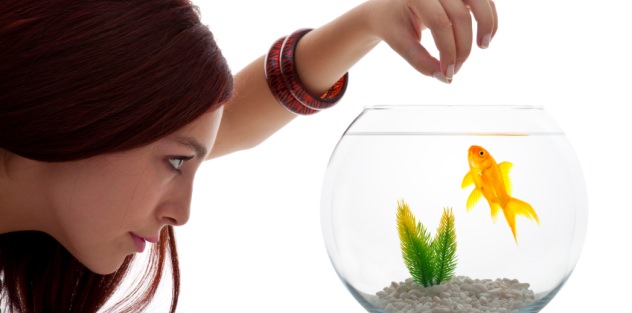
Note: This guide is massive! To aid reading, I condensed each section and included links to related articles for more in-depth information. I also plan to turn this goldfish food guide into a PDF that you can print out and use as a reference. Happy feeding!
Overfeeding is a common problem in aquariums.
If you’re not sure how much goldfish food (or even what) to feed new goldfish, you’re not alone. Horrendous products like this have very low nutritional value, are packed with filler content, and instantly cloud the water during feeding time.
[Goldfish] are hearty feeders and accomplished beggars, and they will gladly encourage you to overfeed them. – David E. Boruchowitz, author of Aquarium Care of Goldfish
Sadly, a majority of fish owners buy their first goldfish without learning the essentials of proper goldfish care beforehand. They’ll buy a goldfish from the pet store, put him into a small glass bowl, and feed the fish so much goldfish food that the filtration system (if they’re using one at all) can’t keep up with the ammonia buildup.
Next thing you know, the poor fish is laying on its side – or swimming upside down!
Too much food can get embedded beneath the gravel and decay, emitting harmful toxins into the water. Too little food can lead to nutritional deficiencies and prevent your goldfish from growing as they should.
In the end, you have very stressed out fish.
If you’ve already lost a goldfish from the above scenario, this guide will help get you back on the right track.
Ready to get those fingers dirty? It starts with understanding how goldfish eat.
It’s Munch Time
Did you know that goldfish actually have teeth in their throat?
No, really. They do.
While goldfish have several small teeth in their jaws for gripping and tearing food, a majority of teeth are in the throat. These teeth make it easier for your goldfish to grind up food and essentially eat that long worm whole (though I still recommend chopping up live worms before feeding young goldfish).
And because goldfish have a protractile jaw (a jaw that can move outward while feeding), they’re pros at finding and nibbling on leftover food buried between the substrate.
Neat, huh?
What’s more, goldfish don’t actually have a “true” stomach. In fact, they don’t have a stomach at all!
This causes all sorts of digestion problems if you feed your fish the wrong goldfish food, feed too much food at once, or even feed food that isn’t prepared in a certain way. Fancy goldfish especially have trouble because of the shape of their bodies (and the position of internal organs).
Luckily you don’t have to worry about that. By the time you’re done with this guide, you’ll be a goldfish food expert.
What’s on the Goldfish Menu Today?
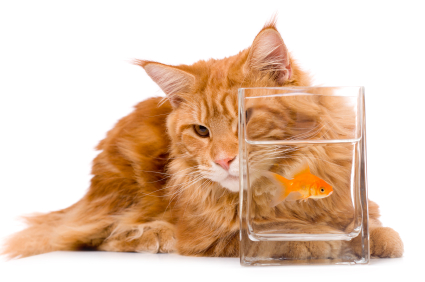
There are so many different brands of goldfish food on the market, ranging from cans of dry food to packages of freeze-dried blood worms.
But be careful! Some brands use tons of cheap fillers in their goldfish food – fillers that don’t actually add real nutritional value. In the end, your goldfish is getting less nutrition with every bite!
Stay away.
While most commercial brands do strive to provide a balanced diet your goldfish need to stay healthy, the level of nutrients actually in goldfish food will vary. By simply looking at the ingredients on the back of the can, you can get a feel of how one brand compares with the next. And later, your goldfish will thank you with vibrant colors and years of entertainment.
To start with, there are several different types of food you can buy. Dry food (including flakes, pellets, sticks, and wafers) are the most used and marketed goldfish food available.
Dry Goldfish Food
Simply browse through the fish aisle at your local pet store, and you’ll see dozens of commercial goldfish food cans on display, most of which are dry food. Some are specially formulated to sink in the water, while others naturally float at the top of the aquarium.
Flakes are known to float at the water surface, while pellets often sink to the gravel below (though not always – you can buy pellets that float as well).
So which should you buy – floating flakes or sinking pellets?
Goldfish graze at both the top and bottom of the aquarium. Though, they do spend most of their time energetically sifting through the substrate for any tasty tidbits they might have missed. Unless your goldfish are sick or sensitive to buoyancy problems, both floating and sinking food will do just fine.
Sick goldfish will usually only touch food that sinks to the bottom.
It’s always good to have sinking pellets on hand to make sure all of your fishy friends get a bite. Since floating dry food can cause goldfish to suck in packets of air, some fish hobbyists only offer their goldfish sinking pellets to avoid problems – like buoyancy and swim bladder issues (which fancy goldfish are especially prone to).
Floating dry food has its advantages though. Flakes and floating pellets are easier to manage. Since they can be quickly removed after the feeding period, they won’t accidentally get caught under rocks and pollute the water.
Ultimately the brand of goldfish food you choose is up to you. If you have trouble making up your mind, you can always feed your goldfish both floating flakes and sinking pellets (variety is always a good way to go).
Live Goldfish Food
Depending on what is offered and how the live food is fed, nutrition can change. Many fish enthusiasts recommend feeding a very nutritious diet to live food before feeding (a process called gutloading) so your goldfish can benefit from the extra nutrition. Best of all, your goldfish will love every bite!
Live goldfish food is an awesome source of protein. In fact, it’s often used to get goldfish ready for breeding. The extra protein is good for young goldfish that are still growing and fancy varieties with developing head growths (like oranda and lionhead goldfish).
You can even cultivate your own live food.
Brine shrimp is a popular choice. You can hatch brine shrimp eggs quickly (within 24 hours under the right conditions) – and it can be quite fun to watch! Of course, unless your feeding goldfish fry, you’ll need to raise the brine shrimp to adulthood before feeding (or they’ll be much too small).
Some fish hobbyists also like feeding goldfish earthworms found after spring showers, though these will need to be thoroughly cleaned (make sure you collect your earthworms from areas where herbicides aren’t used).
Feeding your own live food can be risky though.
If you’re not careful, live goldfish food can contain diseases that will make goldfish sick. Brine shrimp and earthworms usually don’t carry disease, but other foods can.
Thankfully, you can eliminate risk altogether. Most live food is available at the pet store in small amounts (and these are usually 100% safe for goldfish to eat). Live foods available include brine shrimp, daphnia, tubifex worms, glass worms, and aquarium snails. In fact, aquarium snails are a goldfish delicacy!
Frozen and Freeze-dried Food
With frozen or freeze-dried food, your goldfish basically receive all of the nutrients of live food without the risk of infection. And just like live food, your goldfish will go crazy for a bite!
While often available in chunks, freeze-dried goldfish food can be broken up for younger goldfish. Full-grown goldfish are just as happy eating them whole.
Brine shrimp and blood worms are two of the most popular freeze-dried food on the market.
Pet stores also carry tubifex worms, krill, plankton, Mysis shrimp, and daphnia. Krill is especially effective in boosting high carotene levels – necessary for red pigment growth. Carotene also promotes beautiful contrasting colors in goldfish.
If you’re queasy about cultivating your own live food, freeze-dried food is a healthy alternative that your goldfish will love. Since this type of food doesn’t often resemble the organism being fed, you can rest easy knowing your goldfish is still getting a healthy diet.
Occasional Goldfish Treats
Goldfish treats fed once a week or a couple times per month can build excitement during feeding time.
Goldfish are primarily herbivores. Yes, they are omnivores and eat meat as well. But they should also be fed a good diet that includes lots of greens.
Their digestive systems are more sensitive than other species of fish (they don’t have stomachs, after all), so plants make it easier for them to digest their meals. If you feed your goldfish too much meat (and too few vegetables), you’ll run into problems later.
Soft veggies, like frozen peas (with the skin removed), frozen zucchini, boiled broccoli, and diced boiled potatoes can be fed in addition to freeze-dried meals (egg yolk is another favorite, though messy – expect a water change after!).
Veggies are often recommended for older goldfish to help with digestion. Goldfish struggling with swim bladder problems or swimming upside down will also appreciate a few more greens in their diet.
“Planting” lettuce leaves in the gravel will give your goldfish something to munch on if you don’t use live plants often. They’ll also enjoy fresh seaweed from the pet store, and you can use a veggy clip to keep any vegetables you feed underneath the water and in plain view for your goldfish.
But while homemade vegetables are tasty treats, it’s important that you never feed your goldfish anything with spices. Keep vegetables natural and soft by boiling the food or thawing goldfish food out if frozen.
Variety Is Key
Your goldfish will quickly grow bored of eating only one type of goldfish food day after day. Would you like to eat oatmeal every day of the week?
Feeding one type of food can cause other issues as well.
No matter which brand of goldfish food you buy, not one of them will have all of the vitamins and minerals your goldfish need to thrive. Yes, some brands are more nutritious than others, but no brand will fulfill all of your goldfish’s needs at once.
And if your goldfish are lacking in a particular food group, you run the risk of some serious problems down the road. Your goldfish won’t be able to grow properly and could face life-threatening illnesses (nutritional deficiencies are never good).
It’s essential that your goldfish have a varied diet. By offering variety, you can ensure your goldfish always receive the right amount of nutrients to continue growing strong. To keep things exciting, both for you and your goldfish, include all three food types in your goldfish’s diet: dry food, live or freeze-dried food, and your selection of veggies.
Offer one or two dry goldfish food brands as a stable diet daily, then mix in freeze-dried or live food several times per week. Once or twice per week, give your goldfish some lettuce, seaweed – even chopped bananas. But don’t just stick with one brand of food.
Mix it up a bit. Your goldfish will reward you by staying active, happy, and healthy.
Goldfish Food: How Much Is Enough?
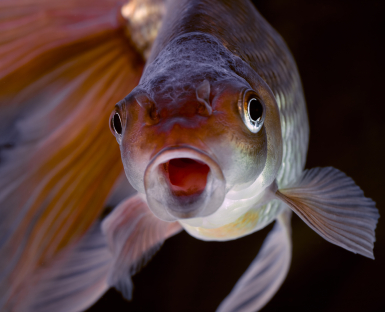
While you might have your own preferences on how much to feed, the general consensus is to feed no more than your goldfish can consume in 5 to 6 minutes (per day, not per feeding).
Pay careful attention to signs that your goldfish has had enough. A slight bulge in the belly and decreased vigor when looking for food are all indicators to stop feeding. Depending on how much your goldfish eat in the time allotted, sometimes a feeding period can last less than five minutes.
But before we get into how much goldfish food to feed, you’ll need to first figure out how frequently you’re going to feed your goldfish (to calculate how much time will go into each feeding session).
Because a goldfish’s digestive system can’t handle so much food at once, strive to feed your goldfish multiple times per day but with less food during each feeding session. So, if your goldfish’s dining schedule includes four or five separate feeding sessions, you’ll only want to feed as much as your fish can consume in one minute or less (probably less).
Personally, I like to feed my goldfish two to three times per day, each feeding session about 1 to 2 minutes long.
Remember that goldfish are cold blooded and require less food than warm-blooded creatures (like you and me). Goldfish don’t need to absorb calories to maintain body heat like we do. So if you’re ever unsure of when to stop feeding your goldfish, you should stop.
Try feeding less when you think you should feed more. Gradually you’ll get the hang of how much food your goldfish really need to thrive.
One of the most harmful things you can do is feed your goldfish too much food.
Going Away for a While? No Worries!
If you’re all set to pack your bags and head out to your next vacation spot, you may worry how your goldfish will cope without food for the duration of your trip. Or, if you should ask a friend or relative to look after your fish while you’re gone.
After all, no one wants to come home to find dead goldfish floating around the tank. But you might be surprised: Goldfish can actually go a long time without goldfish food, as long as water quality is maintained and your fish are in good health.
In his book Aquarium Care of Goldfish, David Boruchowitz states, “A fish without food for a week is just hungry, not starved.”
If you’re going on a short vacation for a week, you probably won’t need to worry.
But if your vacation will take longer than a couple weeks and you’re worried about your goldfish’s welfare, ask a friend or relative to look after your fish every couple of days. You can even write out a feeding plan, or give your goldfish’s temporary caregiver labeled plastic bags with each meal separated.
To Recap…
Your goldfish need a varied, balanced diet if they’re to receive all of the nutrients they need to thrive. While one brand of goldfish food will supply your goldfish with most of the nutrients needed, you should still include other foods (freeze-dried, live, or homemade vegetables) to the diet. Feeding your goldfish one or two brands of dried food most of the time, with freeze-dried or live food and boiled vegetables worked in once or twice a week, is often best.
If you monitor how much your goldfish eat on a daily basis and maintain a healthy aquarium environment, you won’t need to worry about nasty goldfish diseases or malnourished pets.
So what’s on the goldfish menu today?
Share your goldfish care tips in the comments below!
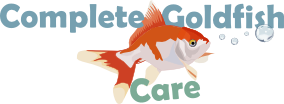

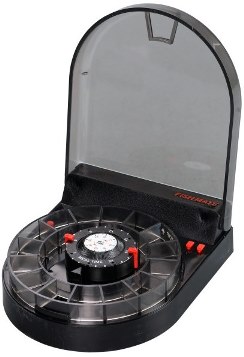
32 comments
Nice, i really like your information. Post any new information from time to time. THANKS^ ^
Thanks, Chris! I’m happy you found the information useful. 🙂
VERY IMPRESSIVE…………..informative too…keep it up.Usually one find articles esp. about fish loaded with misinformation…not this one BRAVO!!!!!!
Thank you, Will! I’m so happy you’ve found this article useful. I too am absolutely appalled by some of the information I see on the Web – some of it just downright leaves a dirty taste in my mouth. Many articles are only based on hearsay and rumors, with very little based on fact, resulting in statements that are flat-out wrong. Even worse, first-time pet owners can unknowingly follow these statements as if they were fact, and then next you have goldfish who could have been thriving and healthy with seriously reduced lifespans.
The focus of this blog is to provide as much accurate information as possible so that first-time pet owners don’t make the mistakes I see time and again. Fish are really at a disadvantage because of the fact that there are so many misconceptions running around rampant, and I want to change this if I can.
I’m glad you got some use out of this article, and I hope others do as well!
can goldfish eat beta fish food? I think we bought the wrong kind
Heidi – your goldfish should have no problems eating the betta food. However, for healthy fish, I do recommend going out and buying food specifically for goldfish as well. Goldfish need a nice supplemented diet for vibrant colors and health.
Bettas are carnivores, while goldfish are omnivores. Feeding your goldfish betta food won’t give them all the nutrients they need from veggies and plants. I’d recommend supplementing their diet with shredded lettuce or spinach. Go easy on the spinach though. Your goldfish would love cooked peas and broccoli as well, as long as the food isn’t seasoned.
I have one goldfish who absolutely adores spinach and gobbles it up like candy, while my other goldfish aren’t too crazy about it. It really depends on their personality and eating preferences, but find the greens they enjoy and they’ll be very happy when it comes time for dinner. 🙂
This was very helpful.
Thanks, Nat!
This is one of the best sites I have found. I am a long time goldfish lover, and have had my current Red-Capped Oranda about 2 years. I have been feeding him pellets, and supplementing with freeze dried brine shrimp. I recently remembered how much fun it was to feed my other goldfish greens, and found your site when I was looking for specific vegetable instructions.
Thanks, Shelli! I love experimenting with greens as well, finding the right balance and watching their behavior during meal time to discover the foods they enjoy most. It’s definitely a nice change from canned food, and it feels good to provide my goldfish with a little something extra. 😉
Excellent information.. Many thanks
Glad the article was useful!
Great info! Thanks!
No problem, Scott! Good luck fish keeping. 🙂
good information 🙂
so is it ok to not feed your goldfish over the weekend?
Hi Kai – your fish should be perfectly fine without food for a couple of days, as long as they’re healthy. Just be careful not to overfeed your fish when you come back! No matter how greedy they might appear. 😉
If I feed my Ryukin goldfish lettuce do I have to boil it? I have baby Ryukins (almost a 1/2 inch long). How can I incorporate a healthy diet besides flakes? I also read somewhere else that you can feed bananas and oranges as well. Is this true? If so, how do I feed the oranges? So far your article has helped me a lot and only need to make sure I’m doing right by my babies.
Hi Victoria,
I’ve never personally tried feeding my goldfish bananas or oranges, but after a quick search it seems to be fine for them. Some reports claim that bananas can get pretty messy, so you may have to do a water change an hour after feeding. From what I read, if you feed your goldfish bananas, don’t feed bananas that are too ripe, as this may cloud the water quickly. Before feeding, cut the banana into small clumps and then drop the pieces in. Take out any leftovers after 2 minutes or water will begin to cloud (and you’ll have to vacuum it out with a water siphon). To feed oranges, peel the orange thoroughly and remove any thick skin that would be difficult for your goldfish to digest. Then cut each orange slice into chunks and feed your goldfish a little at a time.
Apparently goldfish love oranges and bananas, even seedless watermelon. Though, I wouldn’t make this a part of their daily diet. You may want to give some to them once per month as a special treat.
As for lettuce, some goldfish don’t care for it while others don’t mind it. I have two goldfish in one of my tanks, and the lionhead absolutely loves lettuce while the black moor won’t even touch the stuff. They both love spinach though. To feed Romaine lettuce, you can put a few pieces in the freezer for a bit to make them softer and easier to digest. Then simply stick the lettuce on a veggie clip, positioning the clip somewhere on the aquarium glass, and watch your goldfish tear at it. Wait a few minutes and then remove the veggie clip with any leftover lettuce so that it doesn’t cloud the water. No need to cook or cut the lettuce, though you may want to boil spinach lightly before feeding (and rinsing lettuce off before feeding won’t hurt).
a question actually not a comment. I have two gold fish in a decent sized vase and enough air service room. I am going away for the weekend 09-20-09-22-13 and I was wondering if they will be ok for those days. great info by the way. the fish are very healthy I have two. I am asking because I haven’t owned any type of fish in over 14 years.
Hi Ashley,
Are these goldfish new or fully grown? How many gallons does the vase hold?
Your goldfish should be fine without feeding for a couple days. Goldfish can go a while without food. Keep in mind that fancy goldfish require at least 10 gallons per fish (20 gallons for two goldfish).
Hi thank you so much for the advise on goldfish diseases it helped a lot! I have another question, I accedently bought snapped peas instead of frozen peas at the store. Would snapped peas work, or should I go out again and buy frozen peas?
Hi Mallory,
I’m glad to have helped! Snap peas should be okay. Just make sure you feed them de-skinned (or your goldfish might have trouble digesting the skin). Before you de-skin the peas, I’d recommend putting them in the freezer for an hour or so (or boiling them for a minute). The idea is to soften the peas slightly to make them easier for your goldfish to eat (but don’t make them too soft that the peas will dissolve into the water). Then you can de-skin them and slice them into chunks before feeding.
i feed my goldfish once a day, about one pinch of fish food. they seem to have gotten bored of it but they love mushed up steamed peas ( thanks for telling me about them). I am wondering if they would eat krill? they are probably comets. I am thinking of making their diet more interesting, they seem to have grown bored. I’ll ask dad when we go out tomorrow. thanks for all the information. i’ve leaned a lot about them.
Hi Alannah! I’m happy you found the information useful. 🙂 Goldfish will eat krill, but you may need to cut it up for them, since some pieces of krill can be a bit too large for younger goldfish.
I like to vary my goldfish’s diet and offer a different food for each feeding. Goldfish are omnivores, so make sure you feed them both meat and veggies! Peas are fun to feed, but don’t forget the meat as well. Most dry food offers a stable diet with both meat and veggies, though you may want to throw in some blood worms or shrimp every now and then as a little snack. 😉
Some goldfish hobbyists even feed their fish chopped up orange slices, but be careful – you don’t want to feed too much. And always make sure you peel the orange first. Fruit should really be fed about once or twice a month as a special treat.
hi Christina
Like I said, I am trying to make my fish’s diet more interesting, i saw some of the other comments, would it be okay to feed them watermelon then?
Yep, watermelon should be fine! Just make sure you remove the seeds and don’t feed them too much. You should only feed as much as they can eat in a couple minutes. And of course slice up the watermelon into easy-to-eat chunks. Don’t feed your goldfish fruit too often though. I’d recommend about once every couple of weeks or so.
I’m thinking I’m gonna bring my fish with me into the hospital because so far I have spent 3 days then 2 weeks then 7 months straight then 2 weeks then another 2 weeks in hospital and I’m going back in again. do you think my fishes will be ok with the journey?
Hi Kai,
It might be better to just leave your fish at home and have a friend or family member watch over them while you’re away. Goldfish need a lot of space (20-gallons at the minimum for one or two fancy goldfish), so that would be a lot of water to maintain at the hospital. If you’re just going away for a week, your goldfish should be fine without food until you come back. Any longer and you might want to have an automatic feeder in place or someone near home that can feed your goldfish every once in a while, with routine water changes. The journey to and from the hospital might be very stressful for your fish as well.
I had two goldfish out of which one died recently. The other one has not been eating sincd 3 days. I feed them with pellets and bloodworm. What do you think might be the problem?
Hi Anup,
I’m so sorry for your loss! It’s always difficult to lose a pet.
It’s really hard to determine the problem without more information though. Have you tested the aquarium water recently? If so, what were test results? Often, poor water quality is the culprit.
What size aquarium do you have (how many gallons or liters)? Sometimes, overcrowding is the problem. One adult goldfish needs 20 gallons at the very minimum – read my goldfish tank guide for more information on this.
Do you notice any other signs that might hint as to why your goldfish is sick? Any discolored patches on the body? Lumps? Ragged or torn fins? Swollen body? My article on goldfish disease symptoms may help you catch signs of sickness.
Let me know if the problem gets worse. I hope your goldfish feels better!